Is It Easy for a Plaque to Break Off in Heart
Hardening of the arteries
Hardening of the arteries; Arteriosclerosis; Plaque buildup - arteries; Hyperlipidemia - atherosclerosis; Cholesterol - atherosclerosis
Atherosclerosis, sometimes called "hardening of the arteries," occurs when fat, cholesterol, and other substances build up in the walls of arteries. These deposits are called plaques. Over time, these plaques can narrow or completely block the arteries and cause problems throughout the body.
Atherosclerosis is a common disorder.

Blood is the fuel that keeps your body alive and working. It's your blood that transports the oxygen your cells need to survive. To get to your heart and out the rest of your body, blood needs a clear pathway through your arteries. But as you get older - and if you eat too many French fries and cheeseburgers - your arteries can harden and narrow, fill with plaque, leaving less room for blood to flow through. Let's talk today about atherosclerosis. Your arteries are like the pipes your water flows through to get to your bathroom sink. When the pipes are clear, water flows easily through them. But when minerals, rust, and other debris get stuck in the pipes, it clogs them up, leaving less room for water to flow through. That's why you get nothing more than a drip when you turn on your bathroom sink. In your arteries, clogs are caused by plaque. Plaque is a substance made up of fat and cholesterol, which are found in unhealthy foods like those French fries and also bacon. Because plaque is sticky, it collects on your artery walls and blocks the flow of blood. Sometimes a clump of plaque breaks off and floats away to a smaller blood vessel leading to your heart or brain. If it gets stuck in that vessel, you can have a heart attack or stroke. Or, the plaque can weaken an artery wall, which is called an aneurysm. If that aneurysm breaks open, you could have a very life-threatening bleeding. How can you tell if you have atherosclerosis? Well, that's the tricky part, because often atherosclerosis doesn't cause any symptoms until you've got a blocked artery. And by then, you could already be having a heart attack or stroke. So that you don't discover the problem too late, see your doctor for regular check-ups. Get your cholesterol screened by age 35 if you're a man, age 45 if you're a woman. Also have your blood pressure checked every 1 to 2 years before age 50, and then once a year after that. You may need to have your blood pressure checked even more often if you have high blood pressure, heart disease, or you've already had a stroke. Although you can't reverse atherosclerosis once it starts, you can prevent it with some easy lifestyle changes. Eat a balanced diet that's high in heart-healthy fruits, vegetables, and fish. Exercise for at least 30 to 60 minutes a day. Stop smoking, cause that's really bad news for your arteries. If your cholesterol is high, ask your doctor whether you should take cholesterol-lowering medication. Lastly, you may also need to take aspirin or another blood-thinning drug to prevent clots from forming in your arteries.

Atherosclerosis is a condition in which deposits of fatty material, called plaques, develop in the walls of arteries, leading to a reduction or blockage of blood flow. It can affect almost any artery in the body. Atherosclerosis is the most important and most common type of arteriosclerosis, a group of diseases in which the wall of an artery becomes thicker and less elastic. The development of atherosclerosis is complex, but the primary event appears to be injury to the arterial wall. Many different factors can injure the artery's wall, triggering the formation of plaque, for example, turbulent blood flow due to high blood pressure (BP), inflammatory immune responses, certain infections, and chemical abnormalities of the blood, such as diabetes and high cholesterol. Chemical signals that are generated as a result of injury cause white blood cells to attach to the arterial wall, where they collect cholesterol and other fatty material, eventually forming plaque. Over time, the build-up of plaque narrows the space within an artery. Certain risk factors, such as being a male, advanced age, and a family history of early atherosclerosis, cannot be changed. However, to help prevent atherosclerosis, individuals can refrain from tobacco use, decrease low density lipoprotein (LDL) cholesterol levels, lower blood pressure, lose weight, consume fresh fruits and vegetables daily, eat a diet that is low in saturated fats, and exercise regularly. Diabetic individuals need to maintain strict control of their blood sugar. People at high risk for developing atherosclerosis may also benefit from taking certain drugs, such as statins, aspirin, or other antiplatelet drugs.

Atherosclerosis is a disease in which fatty material is deposited on the wall of an artery. Normally, the walls of an artery are smooth, allowing blood to flow unimpeded. However, if damage occurs to its inner lining, fat, cholesterol, platelets, and other substances may accumulate at a damaged section of the arterial wall. Eventually, the tissue builds up and a plaque is formed, narrowing the lumen of the artery. Where the narrowing is severe, there is a risk that the vessel can become blocked completely if a thrombus forms in the diseased segment.
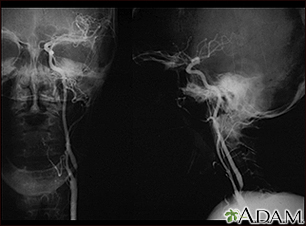
A carotid arteriogram is an X-ray study designed to determine if there is narrowing or other abnormality in the carotid artery, a main artery to the brain. This is an angiogram of the left common carotid artery (both front-to-back and side views) showing a severe narrowing (stenosis) of the internal carotid artery just beyond the division of the common carotid artery into the internal and external branches.
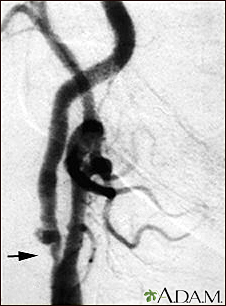
This is an angiogram of the right carotid artery showing a severe narrowing (stenosis) of the internal carotid artery just past the carotid fork. There is enlargement of the artery or ulceration in the area after the stenosis in this close-up film. Note the narrowed segment toward the bottom of the picture.
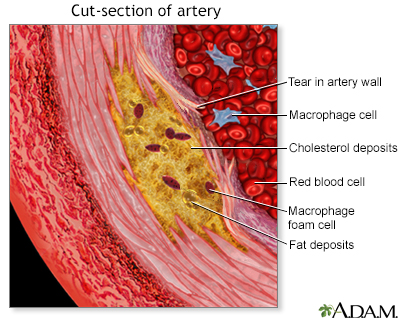
Atherosclerosis is a disease of the arteries in which fatty material and plaque are deposited in the wall of an artery, resulting in narrowing of the arterial lumen and eventual impairment of blood flow.
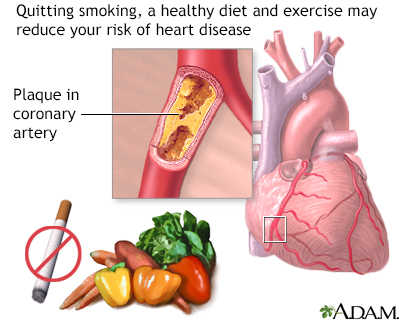
Heart disease may be prevented by recommended healthy diet, regular exercise and to stop smoking if you are a smoker. Follow your health care provider's recommendations for treatment and prevention of heart disease.
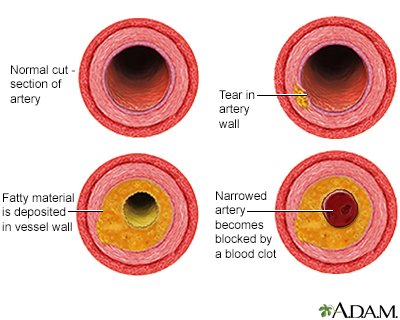
The development of arterial atherosclerosis may occur when deposits of cholesterol and plaque accumulate at a tear in the inner lining of an artery. As the deposits harden and occlude the arterial lumen, blood flow to distant tissues decreases and a clot may become lodged, completely blocking the artery.
Atherosclerosis is a condition in which deposits of fatty material, called plaques, develop in the walls of arteries, leading to a reduction or blockage of blood flow. It can affect almost any artery in the body. Atherosclerosis is the most important and most common type of arteriosclerosis, a group of diseases in which the wall of an artery becomes thicker and less elastic. The development of atherosclerosis is complex, but the primary event appears to be injury to the arterial wall. Many different factors can injure the artery's wall, triggering the formation of plaque, for example, turbulent blood flow due to high blood pressure (BP), inflammatory immune responses, certain infections, and chemical abnormalities of the blood, such as diabetes and high cholesterol. Chemical signals that are generated as a result of injury cause white blood cells to attach to the arterial wall, where they collect cholesterol and other fatty material, eventually forming plaque. Over time, the build-up of plaque narrows the space within an artery. Certain risk factors, such as being a male, advanced age, and a family history of early atherosclerosis, cannot be changed. However, to help prevent atherosclerosis, individuals can refrain from tobacco use, decrease low density lipoprotein (LDL) cholesterol levels, lower blood pressure, lose weight, consume fresh fruits and vegetables daily, eat a diet that is low in saturated fats, and exercise regularly. Diabetic individuals need to maintain strict control of their blood sugar. People at high risk for developing atherosclerosis may also benefit from taking certain drugs, such as statins, aspirin, or other antiplatelet drugs.
Causes
Atherosclerosis often occurs with aging. As you grow older, plaque buildup narrows your arteries and makes them stiffer. These changes make it harder for blood to flow through them.
Clots may form in these narrowed arteries and block blood flow. Pieces of plaque can also break off and move to smaller blood vessels, blocking them.
These blockages starve tissues of blood and oxygen. This can result in damage or tissue death. It is a common cause of heart attack and stroke.
High blood cholesterol levels can cause hardening of the arteries at a younger age.
For many people, high cholesterol levels are due to a diet that is too high in saturated fats and trans fats.
Other factors that can contribute to hardening of the arteries include:
- Diabetes
- Family history of hardening of the arteries
- High blood pressure
- Lack of exercise
- Being overweight or obese
- Smoking
Atherosclerosis is a disease in which fatty material is deposited on the wall of an artery. Normally, the walls of an artery are smooth, allowing blood to flow unimpeded. However, if damage occurs to its inner lining, fat, cholesterol, platelets, and other substances may accumulate at a damaged section of the arterial wall. Eventually, the tissue builds up and a plaque is formed, narrowing the lumen of the artery. Where the narrowing is severe, there is a risk that the vessel can become blocked completely if a thrombus forms in the diseased segment.
Blood is the fuel that keeps your body alive and working. It's your blood that transports the oxygen your cells need to survive. To get to your heart and out the rest of your body, blood needs a clear pathway through your arteries. But as you get older - and if you eat too many French fries and cheeseburgers - your arteries can harden and narrow, fill with plaque, leaving less room for blood to flow through. Let's talk today about atherosclerosis. Your arteries are like the pipes your water flows through to get to your bathroom sink. When the pipes are clear, water flows easily through them. But when minerals, rust, and other debris get stuck in the pipes, it clogs them up, leaving less room for water to flow through. That's why you get nothing more than a drip when you turn on your bathroom sink. In your arteries, clogs are caused by plaque. Plaque is a substance made up of fat and cholesterol, which are found in unhealthy foods like those French fries and also bacon. Because plaque is sticky, it collects on your artery walls and blocks the flow of blood. Sometimes a clump of plaque breaks off and floats away to a smaller blood vessel leading to your heart or brain. If it gets stuck in that vessel, you can have a heart attack or stroke. Or, the plaque can weaken an artery wall, which is called an aneurysm. If that aneurysm breaks open, you could have a very life-threatening bleeding. How can you tell if you have atherosclerosis? Well, that's the tricky part, because often atherosclerosis doesn't cause any symptoms until you've got a blocked artery. And by then, you could already be having a heart attack or stroke. So that you don't discover the problem too late, see your doctor for regular check-ups. Get your cholesterol screened by age 35 if you're a man, age 45 if you're a woman. Also have your blood pressure checked every 1 to 2 years before age 50, and then once a year after that. You may need to have your blood pressure checked even more often if you have high blood pressure, heart disease, or you've already had a stroke. Although you can't reverse atherosclerosis once it starts, you can prevent it with some easy lifestyle changes. Eat a balanced diet that's high in heart-healthy fruits, vegetables, and fish. Exercise for at least 30 to 60 minutes a day. Stop smoking, cause that's really bad news for your arteries. If your cholesterol is high, ask your doctor whether you should take cholesterol-lowering medication. Lastly, you may also need to take aspirin or another blood-thinning drug to prevent clots from forming in your arteries.
Symptoms
Atherosclerosis does not cause symptoms until blood flow to part of the body becomes slowed or blocked.
If the arteries supplying the heart become narrow, blood flow can slow down or stop. This can cause chest pain (stable angina), shortness of breath, and other symptoms.
Narrowed or blocked arteries may also cause problems in the intestines, kidneys, legs, and brain.
Exams and Tests
A health care provider will perform a physical exam and listen to the heart and lungs with a stethoscope. Atherosclerosis can create a whooshing or blowing sound ("bruit") over an artery.
All adults over the age of 18 should have their blood pressure checked every year. More frequent measurement may be needed for those with a history of high blood pressure readings or those with risk factors for high blood pressure.
Cholesterol testing is recommended in all adults. The major national guidelines differ on the suggested age to start testing.
- Screening should begin between ages 20 to 35 for men and ages 20 to 45 for women.
- Repeat testing is not needed for five years for most adults with normal cholesterol levels.
- Repeat testing may be needed if lifestyle changes occur, such as large increase in weight or a change in diet.
- More frequent testing is needed for adults with a history of high cholesterol, diabetes, kidney problems, heart disease, stroke, and other conditions
A number of imaging tests may be used to see how well blood moves through your arteries.
- Doppler tests that use ultrasound or sound waves
- Magnetic resonance arteriography (MRA), a special type of MRI scan
- Special CT scans called CT angiography
- Arteriograms or angiography that use x-rays and contrast material (sometimes called "dye") to see the path of blood flow inside the arteries
Treatment
Lifestyle changes will reduce your risk for atherosclerosis. Things you can do include:
- Quit smoking: This is the single most important change you can make to reduce your risk for heart disease and stroke.
- Avoid fatty foods: Eat well-balanced meals that are low in fat and cholesterol. Include several daily servings of fruits and vegetables. Adding fish to your diet at least twice a week may be helpful. However, do not eat fried fish.
- Limit how much alcohol you drink: Recommended limits are one drink a day for women, two a day for men.
- Get regular physical activity: Exercise with moderate intensity (such as brisk walking) 5 days a week for 30 minutes a day if you are at a healthy weight. For weight loss, exercise for 60 to 90 minutes a day. Talk to your provider before starting a new exercise plan, especially if you have been diagnosed with heart disease or you have ever had a heart attack.
If your blood pressure is high, it is important for you to lower it and keep it under control.
The goal of treatment is to reduce your blood pressure so that you have a lower risk of health problems caused by high blood pressure. You and your provider should set a blood pressure goal for you.
- Do not stop or change high blood pressure medicines without talking to your provider.
Your provider may want you to take medicine for abnormal cholesterol levels or for high blood pressure if lifestyle changes do not work. This will depend on:
- Your age
- The medicines you take
- Your risk of side effects from possible medicines
- Whether you have heart disease or other blood flow problems
- Whether you smoke or are overweight
- Whether you have diabetes or other heart disease risk factors
- Whether you have any other medical problems, such as kidney disease
Your provider may suggest taking aspirin or another medicine to help prevent blood clots from forming in your arteries. These medicines are called antiplatelet drugs. DO NOT take aspirin without first talking to your provider.
Losing weight if you are overweight and reducing blood sugar if you have diabetes or pre-diabetes can help reduce the risk of developing atherosclerosis.
Outlook (Prognosis)
Atherosclerosis cannot be reversed once it has occurred. However, lifestyle changes and treating high cholesterol levels can prevent or slow the process from becoming worse. This can help reduce the chances of having a heart attack and stroke as a result of atherosclerosis.
Possible Complications
In some cases, the plaque is part of a process that causes a weakening of the wall of an artery. This can lead to a bulge in an artery called an aneurysm. Aneurysms can break open (rupture). This causes bleeding that can be life threatening.
References
Arnett DK, Blumenthal RS, Albert MA, Buroker AB, et al. 2019 ACC/AHA Guideline on the primary prevention of cardiovascular disease: executive summary: a report of the American College of Cardiology/American Heart Association Task Force on Clinical Practice Guidelines. J Am Coll Cardiol. 2019;74(10):1376-1414. PMID: 30894319
Genest J, Mora S, Libby P. Lipoprotein disorders and cardiovascular disease. In: Libby P, Bonow RO, Mann DL, Tomaselli GF, Bhatt DL, Solomon SD, eds. Braunwald's Heart Disease: A Textbook of Cardiovascular Medicine. 12th ed. Philadelphia, PA: Elsevier; 2022:chap 27.
Libby P. The vascular biology of atherosclerosis. In: Libby P, Bonow RO, Mann DL, Tomaselli GF, Bhatt DL, Solomon SD, eds. Braunwald's Heart Disease: A Textbook of Cardiovascular Medicine. 12th ed. Philadelphia, PA: Elsevier; 2022: chap 24.
Marks AR. Cardiac and circulatory function. In: Goldman L, Schafer AI, eds. Goldman-Cecil Medicine. 26th ed. Philadelphia, PA: Elsevier; 2020:chap 47.
US Preventive Services Task Force website. Final recommendation statement: statin use for the primary prevention of cardiovascular disease in adults: preventive medication. Updated November 13, 2016. Accessed April 5, 2022.
Whelton PK, Carey RM, Aronow WS, et al. 2017 ACC/AHA/AAPA/ABC/ACPM/AGS/APhA/ASH/ASPC/NMA/PCNA guideline for the prevention, detection, evaluation, and management of high blood pressure in adults: a report of the American College of Cardiology/American Heart Association Task Force on Clinical Practice Guidelines. J Am Coll Cardiol. 2018;71(19):2199-2269. PMID: 2914653
Version Info
Last reviewed on: 1/9/2022
Reviewed by: Michael A. Chen, MD, PhD, Associate Professor of Medicine, Division of Cardiology, Harborview Medical Center, University of Washington Medical School, Seattle, WA. Also reviewed by David Zieve, MD, MHA, Medical Director, Brenda Conaway, Editorial Director, and the A.D.A.M. Editorial team.

Source: https://www.mountsinai.org/health-library/diseases-conditions/hardening-of-the-arteries
0 Response to "Is It Easy for a Plaque to Break Off in Heart"
Post a Comment